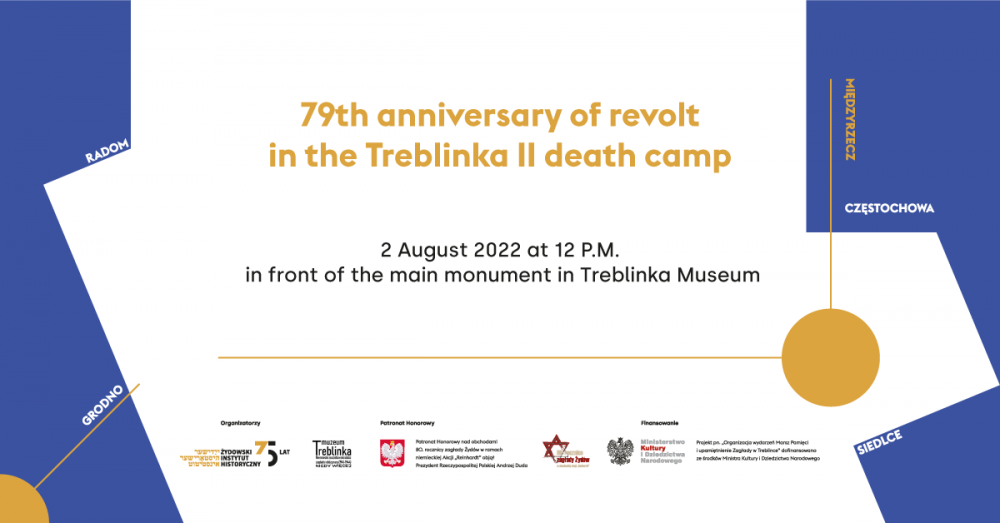Menu
- News
- Events
- Oneg Shabbat
- Collections
- Research
- Exhibitions
- Education
- Publishing Department
- Genealogy
- About the Institute
- Bookstore


In 1942-1943, Germans murdered in Treblinka nearly 900,000 Jews from occupied Poland and other European countries. The first victims were almost 300,000 Jews from the Warsaw Ghetto, who we honor during the annual 22 July 1942 March of Remembrance, organized in Warsaw by the JHI. On August 2, 1943, members of the Sonderkommando – a unit of Jewish prisoners forced to work in the camp – started a rebellion which was aimed at destroying Treblinka, killing SS officers and saving their own lives to tell the world about the Holocaust.
– Treblinka death camp, like camps in Bełżec, Sobibor and Majdanek, was created especially for Operation Reinhardt, which 80 years ago led to the near-total liquidation of Jewish communities in Poland. In 2022, we pay tribute to the victims of this operation. Commemorations of the Treblinka revolt, one of the most important acts of Jewish resistance against the Holocaust, are the central point of this anniversary. – says the JHI director Monika Krawczyk. – Nazi atrocities were documented by Emanuel Ringelblum and his coworkers, creators of the Underground Archive of the Warsaw Ghetto, kept in the Jewish Historical Institute. They tried to pass the information about the Holocaust to the Allies, yet the Jews did not get any help. To remember them is our duty and a warning to future generations.
Of more than 700 prisoners who had taken part in the August 2, 1943 revolt, around 200 managed to escape the camp, and about a hundred survived until the end of the war. Treblinka was almost completely burned down. After the revolt, Germans began liquidating the camp, took down all the buildings and constructions, ploughed the site and planted lupin everywhere so that there would be no sign of one of the worst crimes in history.
The commemorations will take place on August 2 at noon in Treblinka Museum. The Nazi German Extermination and Forced Labor Camp (1941-1944). Representatives of the national and local government and members of the diplomatic corps and clergy will give speeches and prayers and lay wreaths by the Monument of the Death Camp Victims.
Program of the ceremony:
9:15 – departure by buses from Warsaw, from Plac Bankowy (for those joining the JHI delegation)
12:00 – main commemorations by the monument in the central point of the Treblinka Museum. The Nazi German Extermination and Forced Labor Camp (1941-1944) remembrance site
13:00 – end of the official commemorations, guided tour of the Treblinka II extermination camp
14:00 – end of the tour
17:00 – return to Warsaw
Jewish Historical Institute organizes complimentary transportation by bus to the commemorations in Treblinka. More information is available at the Cultural Projects and Communications Department at rsvp@jhi.pl
Contact:
Magdalena Szyszkowska, mszyszkowska@jhi.pl, 785 170 127
Aleksandra Przeździecka-Kujałowicz, aprzezdziecka@jhi.pl, 785 170 126
Cultural Projects and Communications Department of the JHI
Organizers:
The Emanuel Ringelblum Jewish Historical Institute
Treblinka Museum. The Nazi German Extermination and Forced Labor Camp (1941-1944)
*********
In 2022, we honor almost 2 million victims of the “Aktion Reinhardt” – the annihilation campaign against Polish Jews, prepared and executed by the Nazi Germany. From March 1942 until the end of the action in November 1943, Germans exterminated Polish Jews as well as Jews from other European countries: Czech Republic, Slovakia, Greece, Yugoslavia, Bulgaria, Germany and Austria.
The main extermination sites were camps – Bełżec, Sobibór, Treblinka and Majdanek – in which gas was used for killing. Thousands of Jews were also shot on the streets of ghettos and died of thirst and lack of air in the transports. As a result of the “Aktion Reinhardt,” most of large Jewish communities in occupied Poland ceased to exist.
Every day, Germans murdered around 5,000 to 10,000 people using the exhaust fumes from an engine of a tank in gas chambers in Treblinka. Bodies of the murdered people were buried and burned on large grates to cover up the traces of the atrocities. Clothes and valuables brought by the victims were seized and transported to the Reich. Treblinka is the largest cemetery of Polish Jews and one of the largest cemeteries of Polish citizens. We know only the names of about 45,000 of the 900,000 murdered people.
On August 2, 1943, at around 16:00, Jewish prisoners started a revolt. Of more than 700 prisoners who took part in the fighting, around 200 managed to escape the camp, and about a hundred survived until the end of the war.
The last insurgent from Treblinka was Samuel Willenberg from Częstochowa who died in 2016. Every year, he visited Poland on the anniversary of the revolt and participated in commemorations.
![godlo_polski.png [159.74 KB]](https://www.jhi.pl/storage/image/core_files/2022/5/18/06c6c436123fe09134c429cc8cc72c2e/png/jhi/preview/godlo_polski.png)
Commemoration of the 80th anniversary of the extermination of Jews as part of the German Operation "Reinhardt" is under the Honorary Patronage of President of the Republic of Poland Andrzej Duda
![presidentpl_na_niebieskim_2022.jpg [30.06 KB]](https://www.jhi.pl/storage/image/core_files/2022/3/22/89ecd0fc11be8a4b817ceadc5ea0536e/jpg/jhi/preview/presidentpl_na_niebieskim_2022.jpg)
![MKiDN_kolor-eng_od_11.2021.jpg [187.51 KB]](https://www.jhi.pl/storage/image/core_files/2022/1/5/a3fdc096cbdfaeccd0b49be77923fea9/jpg/jhi/preview/MKiDN_kolor-eng_od_11.2021.jpg)
The project "As if we had never existed" was co-financed by the Minister of Culture and National Heritage
![Reinhard_80rocznica-EN transparent light.png [106.99 KB]](https://www.jhi.pl/storage/image/core_files/2022/1/20/b44330260bf6857bc2d3631d1c1678d8/png/jhi/preview/Reinhard_80rocznica-EN%20transparent%20light.png)